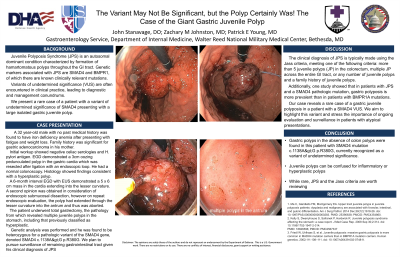Sunday Poster Session
Category: Stomach
P1354 - The Variant May Not Be Significant, but the Polyp Certainly Was! The Case of a Giant Gastric Juvenile Polyp
Sunday, October 22, 2023
3:30 PM - 7:00 PM PT
Location: Exhibit Hall

Has Audio
- JS
John Stanavage, DO
Walter Reed National Military Medical Center
Bethesda, Maryland
Presenting Author(s)
John Stanavage, DO, Zachary Johnston, MD, Patrick Young, MD, FACG
Walter Reed National Military Medical Center, Bethesda, MD
Introduction: Juvenile Polyposis Syndrome (JPS) is an autosomal dominant condition in which hamartomatous polyps may form throughout the GI tract1. Genetic markers associated with JPS are SMAD4 and BMPR1 of which there are several known clinically relevant mutations. Variants of undetermined significance (VUS) are often encountered in clinical practice, leading to diagnostic and management conundrums. We present a rare case of a patient with a variant of undetermined significance of SMAD4 presenting with a large gastric juvenile polyp.
Case Description/Methods: A 32-year-old male with no past medical history was found to have iron deficiency anemia after presenting with fatigue and weight loss. Family history was significant for gastric adenocarcinoma in his mother. Initial workup showed negative celiac serologies and H. pylori antigen. EGD demonstrated a 3cm oozing pedunculated polyp in the gastric cardia which was resected after ligation with an endoscopic loop. He had a normal colonoscopy. Histology showed findings consistent with a hyperplastic polyp. A 6-month interval EGD with EUS demonstrated a 5 x 6 cm mass in the cardia extending into the lesser curvature. A second opinion was obtained in consideration of endoscopic submucosal dissection, however on repeat endoscopic evaluation, the polyp had extended through the lesser curvature into the antrum and thus was aborted. The patient underwent total gastrectomy, the pathology from which revealed multiple juvenile polyps in the stomach, including that previously classified as hyperplastic. He now has complete resolution of his symptoms and anemia. Genetic analysis revealed him to be heterozygous for a VUS of the SMAD4 gene, denoted SMAD4 c.1138A >G p.R380G. We plan to pursue surveillance of his remaining gastrointestinal tract given his clinic diagnosis of JPS.
Discussion: The clinical diagnosis of JPS is typically made using the Jass criteria, meeting one of the following criteria: more than 5 juvenile polyps (JP) in the colorectum, multiple JP across the entire GI tract, or any number of juvenile polyps and a family history of juvenile polyps. Additionally, one study showed that in patients with JPS and a SMAD4 pathologic mutation, gastric polyposis is more prevalent than in patients with BMPR1A mutations.2 Our case reveals a rare case of a gastric juvenile polyposis in a patient with a SMAD4 VUS. We aim to highlight this variant and stress the importance of ongoing evaluation and surveillance in patients with atypical presentations.
Disclosures:
John Stanavage, DO, Zachary Johnston, MD, Patrick Young, MD, FACG. P1354 - The Variant May Not Be Significant, but the Polyp Certainly Was! The Case of a Giant Gastric Juvenile Polyp, ACG 2023 Annual Scientific Meeting Abstracts. Vancouver, BC, Canada: American College of Gastroenterology.
Walter Reed National Military Medical Center, Bethesda, MD
Introduction: Juvenile Polyposis Syndrome (JPS) is an autosomal dominant condition in which hamartomatous polyps may form throughout the GI tract1. Genetic markers associated with JPS are SMAD4 and BMPR1 of which there are several known clinically relevant mutations. Variants of undetermined significance (VUS) are often encountered in clinical practice, leading to diagnostic and management conundrums. We present a rare case of a patient with a variant of undetermined significance of SMAD4 presenting with a large gastric juvenile polyp.
Case Description/Methods: A 32-year-old male with no past medical history was found to have iron deficiency anemia after presenting with fatigue and weight loss. Family history was significant for gastric adenocarcinoma in his mother. Initial workup showed negative celiac serologies and H. pylori antigen. EGD demonstrated a 3cm oozing pedunculated polyp in the gastric cardia which was resected after ligation with an endoscopic loop. He had a normal colonoscopy. Histology showed findings consistent with a hyperplastic polyp. A 6-month interval EGD with EUS demonstrated a 5 x 6 cm mass in the cardia extending into the lesser curvature. A second opinion was obtained in consideration of endoscopic submucosal dissection, however on repeat endoscopic evaluation, the polyp had extended through the lesser curvature into the antrum and thus was aborted. The patient underwent total gastrectomy, the pathology from which revealed multiple juvenile polyps in the stomach, including that previously classified as hyperplastic. He now has complete resolution of his symptoms and anemia. Genetic analysis revealed him to be heterozygous for a VUS of the SMAD4 gene, denoted SMAD4 c.1138A >G p.R380G. We plan to pursue surveillance of his remaining gastrointestinal tract given his clinic diagnosis of JPS.
Discussion: The clinical diagnosis of JPS is typically made using the Jass criteria, meeting one of the following criteria: more than 5 juvenile polyps (JP) in the colorectum, multiple JP across the entire GI tract, or any number of juvenile polyps and a family history of juvenile polyps. Additionally, one study showed that in patients with JPS and a SMAD4 pathologic mutation, gastric polyposis is more prevalent than in patients with BMPR1A mutations.2 Our case reveals a rare case of a gastric juvenile polyposis in a patient with a SMAD4 VUS. We aim to highlight this variant and stress the importance of ongoing evaluation and surveillance in patients with atypical presentations.
Disclosures:
John Stanavage indicated no relevant financial relationships.
Zachary Johnston indicated no relevant financial relationships.
Patrick Young indicated no relevant financial relationships.
John Stanavage, DO, Zachary Johnston, MD, Patrick Young, MD, FACG. P1354 - The Variant May Not Be Significant, but the Polyp Certainly Was! The Case of a Giant Gastric Juvenile Polyp, ACG 2023 Annual Scientific Meeting Abstracts. Vancouver, BC, Canada: American College of Gastroenterology.

